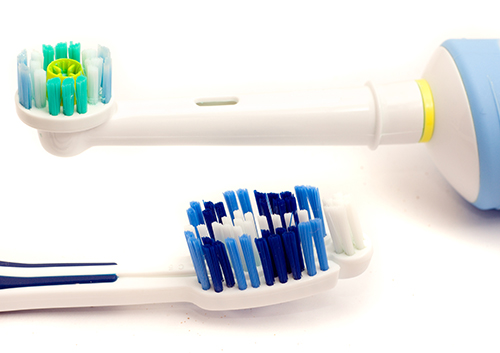August 11th, 2015

Did you know there are as many types of dental fillings as there are flavors of ice cream? Okay, maybe that’s an exaggeration. Still, when you visit the dentist with a cavity, there are many filling options. Most of us just sit in the chair, open our mouths, and let the dentist work his or her magic. But have you ever stopped to consider what the dentist is filling and restoring your decayed or broken tooth with?
Five types of dental fillings
There are five basic kinds of dental filing material. The dentist decides which type to use based on the degree of the decay, the cost of the material, and the type of dental insurance you have.
- Dental amalgam, or silver fillings, have been used to fill cavities for more than 150 years. Dental amalgam is the most common type of dental filling. It's strong, durable, and less expensive than other types.
- Composite fillings, or white fillings, are popular because the color matches the rest of your teeth. Composite fillings are a combination of resin and plastic. They are more aesthetically pleasing than silver fillings, but are also less durable.
- Ceramic fillings are durable and visually appealing (tooth-colored), but they are expensive. They are made of porcelain and have been shown to be resistant to staining.
- Glass ionomers are typically used on children whose teeth are still changing. Constructed from glass and acrylic, glass ionomers are designed to last fewer than five years. The benefit of these dental fillings is that they release fluoride, which protects the changing tooth from further decay.
- Unless you’re a rock or movie star, gold fillings aren’t common. While a gold filling is durable, non-corrosive, and can last more than 15 years, it not only takes more than one dental visit to place, but, as you can imagine, it is expensive.
For more information about fillings, or to schedule an appointment with Drs. Ghenta and Mills, please give us a call at our convenient Dartmouth, MA office!
August 4th, 2015

Temporomandibular joint disorders (TMD) describe a set of conditions that involve trouble with your jaw and face muscles. They result from a problem in the temporomandibular joint (TMJ), which is a hinge that connects the temporal bones, in your skull in front of each ear, to your jaw. The joint enables you to talk, yawn, and chew by letting your mouth move.
TMD can be very painful and interfere with functions such as eating and speaking. This what to watch for and how to try to prevent TMD.
Risk Factors for TMD
You are at higher risk for TMD if you are a women than if you are male. The disorder is most common among adults between the ages of 20 and 40 years. Other risk factors for TMJ disorders include the following.
- Arthritis in the area, making movement more difficult
- Excessive tooth grinding, because it increases stress on the joint
- General stress, which can lead you to clench your teeth and strain facial muscles
Symptoms of TMD
Symptoms of TMD can last for just a short while, or for several years. Seeing Drs. Ghenta and Mills is important if your symptoms make it impossible for you to eat regularly or if you have unbearable pain or discomfort. The following symptoms can occur on both or one side of your face.
- Aching or very tired facial muscles
- Jaws that are fixed open or shut without you being able to unlock them
- Grating or popping sounds when you chew or close or open your mouth
- Pain in the entire area, including the mouth, jaw, neck, or shoulders, that comes on when you chew or yawn
Preventing TMD
You can try to prevent TMD by focusing on reducing risk factors. If you grind your teeth at night, ask Drs. Ghenta and Mills about wearing a mouthguard. If you are overly stressed, look into ways to better manage your stress and relax your muscles. Another strategy for trying to prevent the development of TMD is to avoid chewing gum, since that puts stress on your jaw.
If you have questions about TMD, don’t hesitate to contact our Dartmouth, MA office.
July 28th, 2015

You live in the golden age of toothbrushes. Until a few decades people used twigs or brushes made from animal hair to clean their teeth: not very soft and none too effective.
Now, you have a choice of manual brushes with soft, medium, or hard bristles. Or you might choose to go with an electric toothbrush instead.
Have you ever wondered whether manual or electric brushes provide better cleaning? Actually, they both do the job. The key is to brush and floss every day, regardless of the kind of brush you prefer.
At our Dartmouth, MA office, we like to say the best brush is the one you'll use. So if you prefer manual, go for it. If you prefer electric, turn it on.
Both types have their advantages but both types will get the job done as far as removing plaque.
Electric Toothbrushes
- Provide power rotation that helps loosen plaque
- Are great for people with limited dexterity due to arthritis or other problems
- Are popular with kids who think the electric brushes are more fun to use
- Can come with variable speeds to help reduce pressure on sensitive teeth and gums
Manual Toothbrushes
- Can help brushers feel they have more control over the brushing process
- Allow brushers to respond to twinges and reduce the pressure applied to sensitive teeth and gums
- Are more convenient for packing when traveling
- Manual brushes are cheaper and easier to replace than the electric versions.
In many ways, the golden age is just beginning. There are already phone apps available to remind you to brush and floss. New apps can play two minutes worth of music while you brush, help you compare the brightness of your smile or help explain dental procedures. Maybe someday we’ll even have programs that examine your teeth after brushing and identify spots you might have missed.
July 21st, 2015

It is not uncommon to be concerned about your safety when you have dental X-rays performed. Putting on a heavy lead vest may make you apprehensive. The benefits of dental X-rays far outweigh the risks when safety procedures are followed and the number of X-rays is limited to the required number.
About Dental X-rays
Intraoral X-rays are the most common, and include bitewing X-rays. These allow Drs. Ghenta and Mills and our team at Ghenta and Mills Dental Group to detect caries (cavities) and check the health of your bone and root structure. Extraoral X-rays provide the information we need to monitor your jaw and temporomandibular joint (TMJ), as well as look for impacted teeth and tooth development.
X-ray Safety
A set of four bitewing X-rays exposes you to about 0.005 mSv (millisievert) of radiation, which is equal to the amount of radiation you receive in an average day from natural sources. A panoramic X-ray exposes you to about twice the amount of a bitewing. In both cases the risk is negligible and worth the diagnostic benefits.
Guidelines from the American Dental Association are offered for individuals who are not at high risk for cavities. Children in this group should have X-rays every one or two years. Teenagers should have X-rays every one-and-a-half to three years. Adults can go two to three years between X-rays. If you are at higher risk, yearly X-rays are not harmful and can save your teeth.
No matter what type of X-ray you are having, it is extremely important to tell Drs. Ghenta and Mills or one of our technicians if you are pregnant or may be pregnant. If you are concerned about the number of X-rays you are having done, or about any radiation you are exposed to, please give us a call at our convenient Dartmouth, MA office and talk to us about your concerns.






 Website Powered by Sesame 24-7™
Website Powered by Sesame 24-7™